Methods of release from the action of electric current in electrical installations with a voltage of up to 1000V and above 1000V
This article discusses the main ways to free a person who has become electrocuted. In most cases, a person who has touched parts of an electrical installation that is under voltage cannot free himself. The health and life of the victim in this case entirely depend on the quick and correct actions of the person providing help.
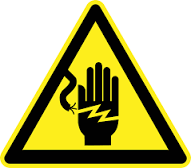
There are different correct methods for freeing the victim from the action of electric current in different cases: when touching live parts on the ground, at height, during the day and at night, at voltages up to and above 1000 volts. Knowing these rules allows you to quickly and clearly react in any situation and often save a person's life.
In the event of an electric shock, it is necessary to free the victim from the action of the current as soon as possible, since the severity of the electrical injury depends on the duration of its action on the body.
Interruption of the electrical installation
Touching live parts that are under tension in most cases causes involuntary convulsive muscle contraction and general excitement, which can lead to disruption and even complete cessation of the activity of the respiratory and circulatory organs. If the victim holds the wire with his hands, his fingers are squeezed so tightly that it becomes impossible to release the wire from his hands. Therefore, the first action of the person providing assistance should be to quickly switch off that part of the electrical installation that the victim is touching.
It is possible to turn off the electrical installation using a switch, a switch with a knife or another disconnecting device (Fig. 1), as well as by removing the fuses, the plug connector, creating an artificial short circuit of the air line (OHL) by «throwing», etc. .n.
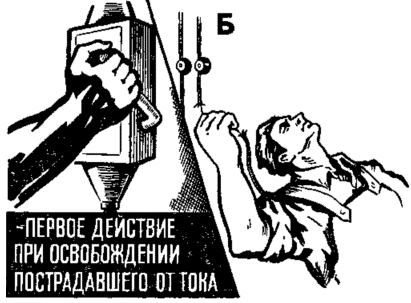
Fig. 1 Release the victim from the action of the current by turning off the electrical installation
If the victim is at a height, turning off the installation and thus freeing the victim from the action of the current may cause him to fall from a height. In this case, measures should be taken to prevent further injury.
When the unit is turned off, the electric lamp can go out at the same time, therefore, in the absence of daylight, it is necessary to provide lighting from another source (turning on emergency lighting, battery lighting, etc., taking into account the risk of explosion and fire in the room), without delaying the shutdown of the device and providing assistance to the victim.
Freeing the victim from live parts without disconnecting the electrical installation
If it is not possible to quickly turn off the electrical installation, then it is necessary to take measures to separate the victim from the live parts that he touches. At the same time, in all cases, the caregiver should not touch the victim without taking appropriate precautions, as this is life-threatening. He must also ensure that he himself does not come into contact with the live part or under the step voltage, being in the area of propagation of the earth fault current.
At voltages up to 1000 V, to separate the victim from live parts or wires, use a rope, stick, board or other dry object that does not conduct electric current (Fig. 2).
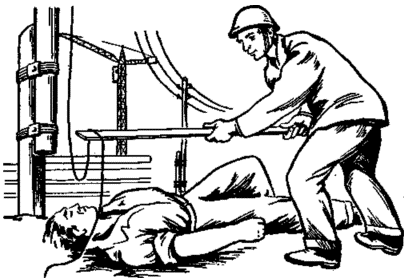
Fig. 2 Freeing the victim from the action of current in electrical installations up to 1000 V by throwing the wire with a board
You can pull the victim by the live parts of the clothing (if they are dry and behind the body), for example, the sides of a jacket or coat, by the collar, while avoiding touching surrounding metal objects and parts of the victim's body that are not covered with clothes (fig. 3).
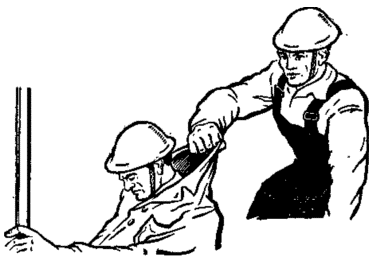
Rice. 3. Freeing the victim from the action of current in installations up to 1000 V by pulling with dry clothing
You can drag the victim by the feet, while the caregiver should not touch his shoes or clothes without good insulation of his hands, because shoes and clothes can be wet and can be conductors of electricity.
To insulate the hands, the helping person, especially if he has to touch the victim's body that is not covered by clothes, should wear dielectric gloves or wrap his hand in a scarf, put on a cloth hat, pull up the sleeve of a jacket or coat over his hand, throw a rubber rug or rubber cloth over the victim (grinder) or just a dry substance.
You can also insulate yourself by standing on a rubber rug, a dry board or some non-conductive mat, a roll of dry clothing, etc. When separating the victim from live parts, use one hand (Fig. 4).
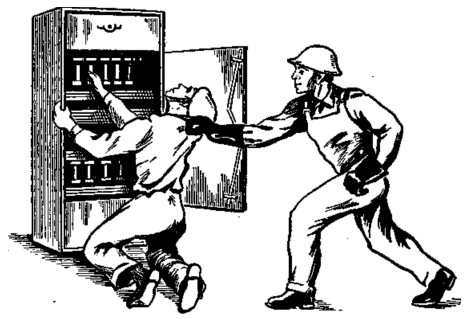
Rice. 4. Separation of the victim from the living part, which is under voltage up to 1000 V
If an electric current passes into the ground through the victim, and he convulsively grips an electric current element (for example, a wire) in his hand, it is easier to interrupt the action of the current by separating the victim from the ground (by slipping a dry board under him or pulling the legs him from the ground with a rope or clothing), while observing the above precautions both for himself and for the victim.
You can also cut the wire with an ax with a dry wooden handle (Fig. 5) or make a break using a tool with insulating handles (knives, pliers, etc.).
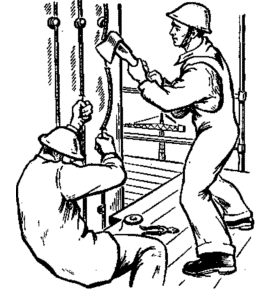
Rice. 5. Freeing the victim from the action of current in installations up to 1000 V by cutting wires
You can use a tool without an insulating handle by wrapping a dry cloth around the handle. It is necessary to cut the wires in stages, that is, cut the wire of each phase separately, while at the same time you need to isolate yourself from the ground (stand on dry boards, a wooden ladder, etc.).
Evacuation of the victim from the live parts of the electrical installation at a voltage of more than 1000 volts
At voltages above 1000 V, in order to separate the victim from live parts, it is necessary to use protective means: to put on dielectric gloves and boots and to act with a bus bar or insulating pliers designed for the corresponding voltage (Fig. 6) .
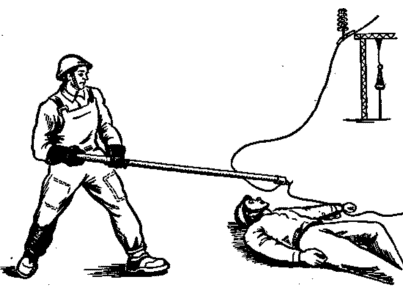
Rice. 6. Freeing the victim from the action of current in installations over 1000 V by throwing the conductor with an insulating rod
On overhead power lines (HV) 6-20 kV, when it is impossible to quickly disconnect them from the power supply side, an artificial short circuit must be created to disconnect the HV. To do this, a flexible uninsulated wire must be thrown over the wires of the overhead line. The thrown wire must have sufficient cross-section to avoid burning when the short-circuit current passes through it.
Before throwing a wire, one end of it must be grounded (connected to the body of a metal support, a grounding slider or a separate ground electrode, etc.), and from the other end, for the convenience of throwing, it is desirable to attach a load. The guide should be disposed of so that it does not touch people, including the person providing assistance and the victim. Dielectric gloves and boots should be used when sketching the wire.
Support be aware of the dangers of step voltage if the live part (wire, etc.) is lying on the ground.It is necessary to move in this area with extreme care, using protective means of isolation from the ground (dielectric wellies, boots, carpets, insulating supports) or objects that do not conduct electricity well (dry boards, logs, etc.).
Without protective equipment, a person must move in the area of the spread of the earth fault current, moving the feet along the ground and not tearing them apart from each other (Fig. 7).
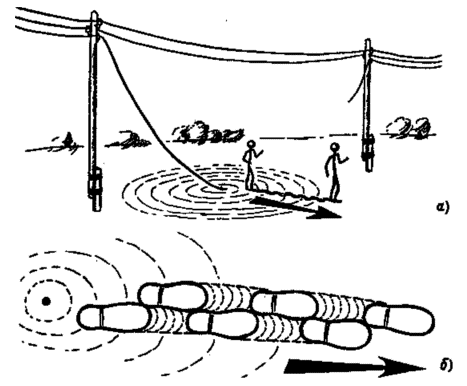
Rice. 7. Correct movement in the current propagation zone of the earth fault: a — distance from the point of the earth fault of the current-carrying part; b — prints
After separating the victim from the live parts, take him out of this area at a distance of at least 8 m from the live part (conductor).
